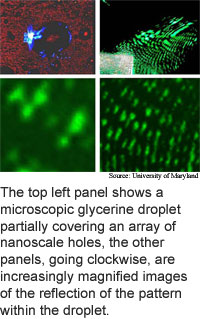
Microdroplet makes mighty microscope
There is a point beyond which it is not
possible to magnify using lenses simply because a lightwave cannot be
focused tighter than about half its wavelength -- the diffraction limit.
Electron microscopes, which bounce electron beams off objects
to create images, and scanning probe microscopes, which trace objects
with mechanical probes, sidestep the problem by avoiding lightwaves. Near-field
microscopes also beat the diffraction limit because they are positioned
closer to the subject in the wavelength of light used.
Researchers from the University of Maryland have found a way to
reach nanometer-scale resolution using ordinary far-field optics. Far-field
optics are generally less expensive and more convenient then electron,
scanning probe and near-field microscopes.
The method could be used for bioimaging and optical nanolithography,
and promises to make it easier to make movies of extremely small objects,
according to the researchers.
The researchers' microscope consists of an ordinary optical microscope,
a gold film, a microscopic glycerine droplet on the gold surface, and
a laser.
The laser produces electromagnetic waves on the gold that are
much smaller than the laser's wavelength. These surface waves are reflected
by the inside surface of the droplet, much like radio waves are reflected
onto a receiver by a dish antenna. An enlarged image of any nanoscale
object in the droplet's focal point is reflected onto the gold film, and
this image is picked up by the optical microscope.
The researchers' prototype uses 515-nanometer wavelength light
to resolve objects smaller than 60 nanometers. Sixty nanometers is about
20 times smaller than an E. coli bacterium. A nanometer is one millionth
of a millimeter.
The technology could be ready for practical use in two or three
years, according to the researchers. The work appeared in the February
11, 2005 issue of Physical Review Letters. -TECHNOLOGY RESEARCH
NEWS
Stories:
Tool turns English to code
Common sense boosts speech software
Inkjet prints human cells
How it Works: Biochips
Briefs:
Nanowires track molecular activity
Microdroplet makes mighty microscope
Cheap material makes speedy memory
Tiny crystals adjust laser colors
Electricity controls biomolecules
Nanotubes juice super batteries
Layers promise cheap circuits

Research Watch blog
View from the High Ground Q&A
How It Works
RSS Feeds:
News
Ad links:
Buy an ad link
Ad links: Clear History
Buy an ad link
|
TRN
Newswire and Headline Feeds for Web sites
|
© Copyright Technology Research News, LLC 2000-2010. All rights reserved.